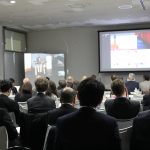Triple offset butterfly valves administer an adept solution for demanding applications when positive isolation is needed in upstream oil and gas operations. Their compatibility bids savings in terms of space and weight requirements, and most importantly, it is economical.
Generally, most offshore and onshore installations are used to ball valves and sometimes gate valves for most flow isolation applications. Several engineers are not yet receptive to what can triple offset butterfly valves can offer. The triple offset butterfly valves, or TOVs, propose benefits in terms of size, weight, and performance against the standard ball or gate valves.

TOV can withstand high pressure, the reason why it is known as a high-pressure butterfly valve. It can be the perfect choice for applications in the turret of floating production storage and offloading vessel (FPSO). Furthermore, in all topside process applications of FPSOs and platforms like water treatment, separators, gas compression, and other systems.
Origin
In the early 1970s, the triple offset butterfly valve was introduced as the next significant development after the traditional high-performance butterfly valves. Its design is entirely different from the conventional butterfly valve, yet, still offering a ninety-degree non-rubbing rotation and zero leakage metal seat.
TOVs hit success from the time they were introduced, for they had a significant impact on upstream oil and gas industries. They are recognized as a robust, reliable, and effective alternative to ball and gate valves.
Because of that, the TOVs are applied in a wide-ranging variety of applications. These types of applications pertain from cryogenic to high temperature and from low to high pressure, where positive isolation is necessary. Ever since their introduction, more than half a million TOVs have been installed globally with an extensive range of sizes, ratings, and materials.
Design
Geometrically speaking, the valve shaft of a TOV is double offset respective to the seat axis and the symmetrical axis of the valve. This act lets a camming feat of the disc as it revolves. Moreover, the valve seat is constructed in a conical form where the tip of the cone has been oriented to the valve’s asymmetrical axis, which presents the third offset. This feature eradicates any rubbing movement of the seal ring with the seat during the ninety degrees rotation.
The advantage of the TOV design is that the valve is torque-seated. This design signifies difference from position-seated, traditional high-performing butterfly valves – where only the position and the intervention among the sealing features generate tightness.
Actuation
The torque in a TOV remains stable throughout the valve’s life since its cycles, temperatures, or applications are autonomous. So whenever selecting an actuator, safety factors do not need much of high regard. Hence, choosing an actuator for a TOV makes it more reliable and economical than choosing an actuator, for instance, with ball valves. The torque of TOV promotes a constant value throughout its lifetime.
Testing
It is essential to highlight how testing is done in a controlled manner of a TOV to assure that zero leakage is attained. Zero leakage is the aptitude to pass an assessment with no visible leakage during the trial duration.
The standard trial method for all TOVs is a zero leakage bench test that always applies a controlled torque. Also, it permits an open face testing – no blind flanges, bubblers, or pipes are utilized. This process allows an inspector to observe the sealing surfaces of the valve whenever it is underneath pressure. Besides, it eliminates any manipulation of the trial to conceal possible leakage, even in quite short test time stated by international standards.
Benefits of a Triple Offset Butterfly Valve in Upstream Applications
- A TOV is beneficial compared to other types of valves that are usually utilized in mos upstream applications.
- A TOV is inherently fire-safe with non-rubbing rotation compared to a soft-seated ball valve.
- Both TOV and soft-seated ball valves guarantee zero leakage. However, the soft components of the soft-seated ball valve are limiting when it comes to applicability and life expectancy of the valve. On the other hand, TOV attains excellent performance with metal-to-metal sealing, no temperature limitation, and much more prolonged product life.
- Weight and space savings are factors that were always considered in upstream applications. TOV installation is simple and easy comparative to ball valves.
- A TOV can be utilized in the same manner for both isolation and control, replacing the two valves generally used – ball valve for isolation and traditional butterfly valve for control.
Conclusion
To sum it up, triple offset butterfly valves are a robust, reliable, and effective alternative to standard ball valves for numerous offshore applications in the upstream oil and gas sector. TOVs bid savings in terms of space and weight requirements, and most importantly, it is economical.











